Gut Microbiota Response to Experimental Acute Cold Stress in Juvenile Yellowfin Tuna (Thunnus albacares)
Abstract
1. Introduction
2. Materials and Methods
2.1. Experimental Fish and Design
2.2. DNA Extraction, PCR Amplification, and Construction of a 16S rDNA Library
2.3. Bioinformatics Analysis
2.4. Statistical Analysis
3. Results
3.1. Distribution of the 16S rRNA Gene Library
3.2. Analysis of α-Diversity and the Number of OTUs Among Different Treatment Groups
3.3. Diversity and Composition of Gut Microbiota Among Different Treatment Groups
3.4. Analysis of α-Diversity and Distribution of OTUs over Time in Different Low-Temperature Treatment Groups
3.5. Diversity and Analysis of Gut Microbiota in Different Low-Temperature Treatment Groups
4. Discussion
5. Conclusions
Supplementary Materials
Author Contributions
Funding
Institutional Review Board Statement
Data Availability Statement
Conflicts of Interest
References
- Merrifield, D.L.; Rodiles, A. The Fish Microbiome and Its Interactions with Mucosal Tissues. In Mucosal Health in Aquaculture; Elsevier: Amsterdam, The Netherlands, 2015; pp. 273–295. [Google Scholar]
- Banerjee, G.; Ray, A.K. Bacterial Symbiosis in the Fish Gut and Its Role in Health and Metabolism. Symbiosis 2017, 72, 1–11. [Google Scholar] [CrossRef]
- Sehnal, L.; Brammer-Robbins, E.; Wormington, A.M.; Blaha, L.; Bisesi, J.; Larkin, I.; Martyniuk, C.J.; Simonin, M.; Adamovsky, O. Microbiome Composition and Function in Aquatic Vertebrates: Small Organisms Making Big Impacts on Aquatic Animal Health. Front. Microbiol. 2021, 12, 567408. [Google Scholar] [CrossRef]
- Romero, J.; Ringø, E.; Merrifield, D.L. The Gut Microbiota of Fish. In Aquaculture Nutrition: Gut Health, Probiotics and Prebiotics; John Wiley & Sons, Ltd.: Hoboken, NJ, USA, 2014; pp. 75–100. [Google Scholar]
- Altringham, J.D.; Block, B.A. Why Do Tuna Maintain Elevated Slow Muscle Temperatures? Power Output of Muscle Isolated from Endothermic and Ectothermic Fish. J. Exp. Biol. 1997, 200, 2617–2627. [Google Scholar] [CrossRef]
- Stevens, E.D.; Neill, W.H. Body Temperature Relations of Tunas, Especially Skipjack. In Fish Physiology; Elsevier: Amsterdam, The Netherlands, 1978; pp. 315–359. [Google Scholar]
- Zhang, L.; Yang, Z.; Yang, F.; Wang, G.; Zeng, M.; Zhang, Z.; Yang, M.; Wang, Z.; Li, Z. Gut Microbiota of Two Invasive Fishes Respond Differently to Temperature. Front. Microbiol. 2023, 14, 1087777. [Google Scholar] [CrossRef] [PubMed]
- Sepulveda, J.; Moeller, A.H. The Effects of Temperature on Animal Gut Microbiomes. Front. Microbiol. 2020, 11, 384. [Google Scholar] [CrossRef]
- Wang, B.; Zhang, S.-Q.; Dong, J.-L.; Li, Y.; Jin, Y.-X.; Xiao, H.-W.; Wang, H.-C.; Fan, S.-J.; Cui, M. Ambient Temperature Structures the Gut Microbiota of Zebrafish to Impact the Response to Radioactive Pollution. Environ. Pollut. 2022, 293, 118539. [Google Scholar] [CrossRef] [PubMed]
- Li, P.; Zhang, J.; Liu, X.; Gan, L.; Xie, Y.; Zhang, H.; Si, J. The Function and the Affecting Factors of the Zebrafish Gut Microbiota. Front. Microbiol. 2022, 13, 903471. [Google Scholar] [CrossRef]
- Block, B.A.; Keen, J.E.; Castillo, B.; Dewar, H.; Freund, E.V.; Marcinek, D.J.; Brill, R.W.; Farwell, C. Environmental Preferences of Yellowfin Tuna (Thunnus albacares) at the Northern Extent of Its Range. Mar. Biol. 1997, 130, 119–132. [Google Scholar] [CrossRef]
- Artetxe-Arrate, I.; Fraile, I.; Marsac, F.; Farley, J.H.; Rodriguez-Ezpeleta, N.; Davies, C.R.; Clear, N.P.; Grewe, P.; Murua, H. A Review of the Fisheries, Life History and Stock Structure of Tropical Tuna (Skipjack Katsuwonus pelamis, Yellowfin Thunnus albacares and Bigeye Thunnus obesus) in the Indian Ocean. Adv. Mar. Biol. 2021, 88, 39–89. [Google Scholar]
- Lan, K.-W.; Evans, K.; Lee, M.-A. Effects of Climate Variability on the Distribution and Fishing Conditions of Yellowfin Tuna (Thunnus albacares) in the Western Indian Ocean. Clim. Change 2013, 119, 63–77. [Google Scholar] [CrossRef]
- Lilly, L.E.; Bonaventura, J.; Lipnick, M.S.; Block, B.A. Effect of Temperature Acclimation on Red Blood Cell Oxygen Affinity in Pacific Bluefin Tuna (Thunnus orientalis) and Yellowfin Tuna (Thunnus albacares). Comp. Biochem. Physiol. Part A Mol. Integr. Physiol. 2015, 181, 36–44. [Google Scholar] [CrossRef] [PubMed]
- Sun, W.; Zhang, J.; Meng, J.; Liu, Y. Sea Surface Temperature Characteristics and Trends in China Offshore Seas from 1982 to 2017. J. Coast. Res. 2019, 90, 27–34. [Google Scholar] [CrossRef]
- Schwing, F.B.; Murphree, T.; deWitt, L.; Green, P.M. The Evolution of Oceanic and Atmospheric Anomalies in the Northeast Pacific During the El Niño and La Niña Events of 1995–2001. Prog. Oceanogr. 2002, 54, 459–491. [Google Scholar] [CrossRef]
- Pörtner, H.-O.; Berdal, B.; Blust, R.; Brix, O.; Colosimo, A.; De Wachter, B.; Giuliani, A.; Johansen, T.; Fischer, T.; Knust, R.; et al. Climate Induced Temperature Effects on Growth Performance, Fecundity and Recruitment in Marine Fish: Developing a Hypothesis for Cause and Effect Relationships in Atlantic Cod (Gadus morhua) and Common Eelpout (Zoarces viviparus). Cont. Shelf Res. 2001, 21, 1975–1997. [Google Scholar] [CrossRef]
- McKenzie, D.J.; Axelsson, M.; Chabot, D.; Claireaux, G.; Cooke, S.J.; Corner, R.A.; De Boeck, G.; Domenici, P.; Guerreiro, P.M.; Hamer, B.; et al. Conservation Physiology of Marine Fishes: State of the Art and Prospects for Policy. Conserv. Physiol. 2016, 4, cow046. [Google Scholar] [CrossRef]
- Crawshaw, L.I. Low-Temperature Dormancy in Fish. Am. J. Physiol.-Regul. Integr. Comp. Physiol. 1984, 246, R479–R486. [Google Scholar] [CrossRef]
- Liu, Y.; Lv, H.; Xu, L.; Zhang, K.; Mei, Y.; Chen, J.; Wang, M.; Guan, Y.; Pang, H.; Wang, Y.; et al. The Effect of Dietary Lactic Acid Bacteria on Intestinal Microbiota and Immune Responses of Crucian Carp (Carassius auratus) under Water Temperature Decrease. Front. Microbiol. 2022, 13, 847167. [Google Scholar] [CrossRef] [PubMed]
- Lv, H.; Liu, Y.; Li, H.; Yin, X.; Wang, P.; Qu, X.; Gao, Y.; Li, W.; Chu, Z. Modulation of Antioxidant Enzymes, Heat Shock Protein, and Intestinal Microbiota of Large Yellow Croaker (Larimichthys crocea) under Acute Cold Stress. Front. Mar. Sci. 2021, 8, 725899. [Google Scholar] [CrossRef]
- Liu, C.; Zhao, L.-P.; Shen, Y.-Q. A Systematic Review of Advances in Intestinal Microflora of Fish. Fish Physiol. Biochem. 2021, 47, 2041–2053. [Google Scholar] [CrossRef]
- Chen, C.-Z.; Li, P.; Liu, L.; Li, Z.-H. Exploring the Interactions between the Gut Microbiome and the Shifting Surrounding Aquatic Environment in Fisheries and Aquaculture: A Review. Environ. Res. 2022, 214, 114202. [Google Scholar] [CrossRef]
- Bakke, A.M.; Glover, C.; Krogdahl, Å. Feeding, Digestion and Absorption of Nutrients. In Fish Physiology; Elsevier: Amsterdam, The Netherlands, 2010; pp. 57–110. [Google Scholar]
- Ray, A.K.; Ringø, E. The Gastrointestinal Tract of Fish. In Aquaculture Nutrition: Gut Health, Probiotics and Prebiotics; John Wiley & Sons, Ltd.: Hoboken, NJ, USA, 2014; pp. 1–13. [Google Scholar]
- Lobionda, S.; Sittipo, P.; Kwon, H.Y.; Lee, Y.K. The Role of Gut Microbiota in Intestinal Inflammation with Respect to Diet and Extrinsic Stressors. Microorganisms 2019, 7, 271. [Google Scholar] [CrossRef]
- Gasaly, N.; de Vos, P.; Hermoso, M.A. Impact of Bacterial Metabolites on Gut Barrier Function and Host Immunity: A Focus on Bacterial Metabolism and Its Relevance for Intestinal Inflammation. Front. Immunol. 2021, 12, 658354. [Google Scholar] [CrossRef]
- Hansen, G.H.; Olafsen, J.A. Bacterial Interactions in Early Life Stages of Marine Cold Water Fish. Microb. Ecol. 1999, 38, 1–26. [Google Scholar] [CrossRef] [PubMed]
- Yan, H.; Soon, W.; Wang, Y. A Composite Sea Surface Temperature Record of the Northern South China Sea for the Past 2500 Years: A Unique Look into Seasonality and Seasonal Climate Changes During Warm and Cold Periods. Earth-Sci. Rev. 2015, 141, 122–135. [Google Scholar] [CrossRef]
- Cakin, I.; Morrissey, B.; Gordon, M.; Gaffney, P.P.; Marcello, L.; Macgregor, K.; Taggart, M.A. Comparing DNA Isolation and Sequencing Strategies for 16S rRNA Gene Amplicon Analysis in Biofilm Containing Environments. J. Microbiol. Methods 2024, 220, 106921. [Google Scholar] [CrossRef] [PubMed]
- Schloss, P.D.; Westcott, S.L.; Ryabin, T.; Hall, J.R.; Hartmann, M.; Hollister, E.B.; Lesniewski, R.A.; Oakley, B.B.; Parks, D.H.; Robinson, C.J.; et al. Introducing Mothur: Open-Source, Platform-Independent, Community-Supported Software for Describing and Comparing Microbial Communities. Appl. Environ. Microbiol. 2009, 75, 7537–7541. [Google Scholar] [CrossRef] [PubMed]
- Edgar, R.C.; Haas, B.J.; Clemente, J.C.; Quince, C.; Knight, R. Uchime Improves Sensitivity and Speed of Chimera Detection. Bioinformatics 2011, 27, 2194–2200. [Google Scholar] [CrossRef]
- Lan, Y.; Wang, Q.; Cole, J.R.; Rosen, G.L. Using the Rdp Classifier to Predict Taxonomic Novelty and Reduce the Search Space for Finding Novel Organisms. PLoS ONE 2012, 7, e32491. [Google Scholar] [CrossRef]
- Koetschan, C.; Kittelmann, S.; Lu, J.; Al-Halbouni, D.; Jarvis, G.N.; Müller, T.; Wolf, M.; Janssen, P.H. Internal Transcribed Spacer 1 Secondary Structure Analysis Reveals a Common Core Throughout the Anaerobic Fungi (Neocallimastigomycota). PLoS ONE 2014, 9, e91928. [Google Scholar] [CrossRef]
- Kang, X.; Liu, G.; Liu, Y.; Xu, Q.; Zhang, M.; Fang, M. Transcriptome Profile at Different Physiological Stages Reveals Potential Mode for Curly Fleece in Chinese Tan Sheep. PLoS ONE 2013, 8, e71763. [Google Scholar] [CrossRef]
- Hong, J.; Chen, M.; Deng, Z.; Li, Y.; Wang, Y. Variance Analysis of Intestinal Microbial Diversity of the Noble Scallop (Chlamys nobilis) under Enrofloxacin Exposure. Pak. J. Zool. 2021, 53, 1221–1231. [Google Scholar] [CrossRef]
- Ming, J.; Fu, Z.; Ma, Z.; Zhou, L.; Zhang, Z.; Song, C.; Yuan, X.; Wu, Q. The Effect of Sulfamonomethoxine Treatment on the Gut Microbiota of Nile Tilapia (Oreochromis niloticus). MicrobiologyOpen 2020, 9, e1116. [Google Scholar] [CrossRef]
- Kim, J.A.; Park, Y.-S.; Kim, J.-H.; Choi, C.Y. Impact of Water Temperature on Oxidative Stress and Intestinal Microbiota in Pearl-Spot Chromis, Chromis notata (Temminck & Schlegel, 1843). Comp. Biochem. Physiol. Part B Biochem. Mol. Biol. 2024, 275, 111029. [Google Scholar]
- Li, R.-X.; Amenyogbe, E.; Lu, Y.; Jin, J.-H.; Xie, R.-T.; Huang, J.-S. Effects of Low-Temperature Stress on Serum Biochemical Indicators, Intestinal Microbiome, and Transcriptome of Juvenile Golden Pompano (Trachinotus ovatus). Aquac. Int. 2024, 32, 5551–5578. [Google Scholar] [CrossRef]
- Hu, J.; Zhao, H.; Wang, G.; Sun, Y.; Wang, L. Energy Consumption and Intestinal Microbiome Disorders of Yellow Catfish (Pelteobagrus fulvidraco) under Cold Stress. Front. Physiol. 2022, 13, 985046. [Google Scholar] [CrossRef]
- Ma, S.; Lv, Y.; Hou, L.; Jia, Z.; Lin, S.; Wang, S.; He, X.; Hou, J. Effect of Acute Temperature Stress on Energy Metabolism, Immune Performance and Gut Microbiome of Largemouth Bass (Micropterus salmoides). Aquac. Fish. 2023, in press. [CrossRef]
- Murashita, K.; Hashimoto, H.; Takashi, T.; Eba, T.; Kumon, K.; Matsunari, H.; Soma, S.; Oku, H.; Furuita, H.; Yoshinaga, H.; et al. Characterization of Digestive Physiology in Pacific Bluefin Tuna Thunnus orientalis juveniles fed a raw fish feed and a commercial diet. Aquaculture 2021, 538, 736562. [Google Scholar] [CrossRef]
- Villarini, G.; Vecchi, G.A. Multiseason Lead Forecast of the North Atlantic Power Dissipation Index (PDI) and Accumulated Cyclone Energy (ACE). J. Clim. 2013, 26, 3631–3643. [Google Scholar] [CrossRef]
- Li, R.-X.; Amenyogbe, E.; Lu, Y.; Jin, J.-H.; Xie, R.-T.; Huang, J.-S. Effects of Low-Temperature Stress on Intestinal Structure, Enzyme Activities and Metabolomic Analysis of Juvenile Golden Pompano (Trachinotus ovatus). Front. Mar. Sci. 2023, 10, 1114120. [Google Scholar] [CrossRef]
- Liu, Y.; Cheng, J.; Xia, Y.; Li, X.; Liu, Y.; Liu, P.-F. Response Mechanism of Gut Microbiome and Metabolism of European Seabass (Dicentrarchus labrax) to Temperature Stress. Sci. Total Environ. 2022, 813, 151786. [Google Scholar] [CrossRef]
- Huus, K.E.; Ley, R.E. Blowing Hot and Cold: Body Temperature and the Microbiome. mSystems 2021, 6, e0070721. [Google Scholar] [CrossRef] [PubMed]
- Zhou, C.; Yang, S.; Ka, W.; Gao, P.; Li, Y.; Long, R.; Wang, J. Association of Gut Microbiota with Metabolism in Rainbow Trout under Acute Heat Stress. Front. Microbiol. 2022, 13, 846336. [Google Scholar] [CrossRef] [PubMed]
- Yoon, D.-S.; Kim, D.-H.; Kim, J.-H.; Sakakura, Y.; Hagiwara, A.; Park, H.G.; Lee, M.-C.; Lee, J.-S. Interactions Between Lipid Metabolism and the Microbiome in Aquatic Organisms: A Review. Mar. Pollut. Bull. 2024, 207, 116858. [Google Scholar] [CrossRef] [PubMed]
- Huang, K.; He, Y.; Wang, W.; Jiang, R.; Zhang, Y.; Li, J.; Zhang, X.-X.; Wang, D. Temporal Differentiation in the Adaptation of Functional Bacteria to Low-Temperature Stress in Partial Denitrification and Anammox System. Environ. Res. 2024, 244, 117933. [Google Scholar] [CrossRef]
- Quatrini, R.; Johnson, D.B. Microbiomes in Extremely Acidic Environments: Functionalities and Interactions That Allow Survival and Growth of Prokaryotes at Low pH. Curr. Opin. Microbiol. 2018, 43, 139–147. [Google Scholar] [CrossRef]
- Reineke, W.; Schlömann, M. Carbon Cycle. In Environmental Microbiology; Springer: Berlin/Heidelberg, Germany, 2023; pp. 71–126. [Google Scholar]
- Wasmund, K.; Pelikan, C.; Schintlmeister, A.; Wagner, M.; Watzka, M.; Richter, A.; Bhatnagar, S.; Noel, A.; Hubert, C.R.J.; Rattei, T. Genomic Insights into Diverse Bacterial Taxa That Degrade Extracellular DNA in Marine Sediments. Nat. Microbiol. 2021, 6, 885–898. [Google Scholar] [CrossRef]
- Sun, Y.; Zhang, S.; Nie, Q.; He, H.; Tan, H.; Geng, F.; Ji, H.; Hu, J.; Nie, S. Gut Firmicutes: Relationship with Dietary Fiber and Role in Host Homeostasis. Crit. Rev. Food Sci. Nutr. 2023, 63, 12073–12088. [Google Scholar] [CrossRef]
- Towner, K.J. The Genus Acinetobacter. In The Prokaryotes: A Handbook on the Biology of Bacteria: Ecophysiology, Isolation, Identification, Applications; Springer: Berlin/Heidelberg, Germany, 1992; pp. 3137–3143. [Google Scholar]
- Wang, X.-Y.; Xie, J. Characterization of Metabolite, Genome and Volatile Organic Compound Changes Provides Insights into the Spoilage and Cold Adaptive Markers of Acinetobacter Johnsonii XY27. LWT 2022, 162, 113453. [Google Scholar] [CrossRef]
- Yi, W.; Cheng, J.; Wei, Q.; Pan, R.; Song, S.; He, Y.; Tang, C.; Liu, X.; Zhou, Y.; Su, H. Effect of Temperature Stress on Gut-Brain Axis in Mice: Regulation of Intestinal Microbiome and Central Nlrp3 Inflammasomes. Sci. Total Environ. 2021, 772, 144568. [Google Scholar] [CrossRef]
- Sanahuja, I.; Fernández-Alacid, L.; Sánchez-Nuño, S.; Ordóñez-Grande, B.; Ibarz, A. Chronic Cold Stress Alters the Skin Mucus Interactome in a Temperate Fish Model. Front. Physiol. 2019, 9, 1916. [Google Scholar] [CrossRef]
- Zhang, X.-Y.; Sukhchuluun, G.; Bo, T.-B.; Chi, Q.-S.; Yang, J.-J.; Chen, B.; Zhang, L.; Wang, D.-H. Huddling Remodels Gut Microbiota to Reduce Energy Requirements in a Small Mammal Species During Cold Exposure. Microbiome 2018, 6, 103. [Google Scholar]
- Zhang, X.-Y.; Wang, D.-H. Gut Microbial Community and Host Thermoregulation in Small Mammals. Front. Physiol. 2022, 13, 888324. [Google Scholar] [CrossRef]
- Pan, Y.; Sun, R.-Z.; Wang, Y.; Chen, G.-L.; Fu, Y.-Y.; Yu, H.-Q. Carbon Source Shaped Microbial Ecology, Metabolism and Performance in Denitrification Systems. Water Res. 2023, 243, 120330. [Google Scholar] [CrossRef] [PubMed]
- Panah, F.M.; Lauridsen, C.; Højberg, O.; Jensen, H.E.; Nielsen, T.S. Composition of Mucus-and Digesta-Associated Bacteria in Growing Pigs with and without Diarrhea Differed According to the Presence of Colonic Inflammation. BMC Microbiol. 2023, 23, 145. [Google Scholar] [CrossRef]
- Carey, H.V.; Assadi-Porter, F.M. The Hibernator Microbiome: Host-Bacterial Interactions in an Extreme Nutritional Symbiosis. Annu. Rev. Nutr. 2017, 37, 477–500. [Google Scholar] [CrossRef] [PubMed]
- Zhang, F.; Zhao, Y.; Liu, X.; Li, Z.; Liu, N.; Tang, L.; Jiang, Q.; Fan, Z.; Tan, B.; Li, Y.; et al. Effects of Soluble Glucomannan and Insoluble Cellulose Treatment on Mucin Secretion and Mucin Glycosylation-Related Gene Expression in the Colons of Mice. J. Sci. Food Agric. 2023, 103, 7739–7746. [Google Scholar] [CrossRef]
- Karl, J.P.; Hatch, A.M.; Arcidiacono, S.M.; Pearce, S.C.; Pantoja-Feliciano, I.G.; Doherty, L.A.; Soares, J.W. Effects of Psychological, Environmental and Physical Stressors on the Gut Microbiota. Front. Microbiol. 2018, 9, 2013. [Google Scholar] [CrossRef]
- Ma, X.; La, Y.; Yang, G.; Dai, R.; Zhang, J.; Zhang, Y.; Jin, J.; Ma, X.; Guo, X.; Chu, M.; et al. Multi-Omics Revealed the Effects of Dietary Energy Levels on the Rumen Microbiota and Metabolites in Yaks under House-Feeding Conditions. Front. Microbiol. 2024, 14, 1309535. [Google Scholar] [CrossRef]
- Biosca, E.G.; Amaro, C.; Marco-Noales, E.; Oliver, J.D. Effect of Low Temperature on Starvation-Survival of the Eel Pathogen Vibrio Vulnificus Biotype 2. Appl. Environ. Microbiol. 1996, 62, 450–455. [Google Scholar] [CrossRef]
- Tardy, F.; Mick, V.; Dordet-Frisoni, E.; Marenda, M.S.; Sirand-Pugnet, P.; Blanchard, A.; Citti, C. Integrative Conjugative Elements Are Widespread in Field Isolates of Mycoplasma Species Pathogenic for Ruminants. Appl. Environ. Microbiol. 2015, 81, 1634–1643. [Google Scholar] [CrossRef]
- Kaboré, O.D.; Godreuil, S.; Drancourt, M. Planctomycetes as Host-Associated Bacteria: A Perspective That Holds Promise for Their Future Isolations, by Mimicking Their Native Environmental Niches in Clinical Microbiology Laboratories. Front. Cell. Infect. Microbiol. 2020, 10, 519301. [Google Scholar] [CrossRef] [PubMed]
- Gaca, A.O.; Lemos, J.A. Adaptation to Adversity: The Intermingling of Stress Tolerance and Pathogenesis in Enterococci. Microbiol. Mol. Biol. Rev. 2019, 83, e00074-18. [Google Scholar] [CrossRef] [PubMed]
- Singleton, F.L.; Attwell, R.; Jangi, S.; Colwell, R.R. Effects of Temperature and Salinity on Vibrio Cholerae Growth. Appl. Environ. Microbiol. 1982, 44, 1047–1058. [Google Scholar] [CrossRef] [PubMed]
- Percival, S.L.; Yates, M.V.; Williams, D.W.; Chalmers, R.M.; Gray, N.F. Acinetobacter. In Microbiology of Waterborne Diseases; Elsevier: Amsterdam, The Netherlands, 2014; pp. 35–48. [Google Scholar]
- Kour, D.; Yadav, A.N. Alleviation of Cold Stress in Wheat with Psychrotrophic Phosphorus Solubilizing Acinetobacter Rhizosphaerae Eu-Kl44. Braz. J. Microbiol. 2023, 54, 371–383. [Google Scholar] [CrossRef]
- Asaf, S.; Numan, M.; Khan, A.L.; Al-Harrasi, A. Sphingomonas: From Diversity and Genomics to Functional Role in Environmental Remediation and Plant Growth. Crit. Rev. Biotechnol. 2020, 40, 138–152. [Google Scholar] [CrossRef]
- Yi, X.; Guo, H.; Deng, J.; Bai, Z.J.; Shi, X.F.; Qiang, J.B. Effect of Sphingomonas polyaromaticivorans on Spontaneous Combustion of Lignite During Low-Temperature Oxidation. Fuel 2024, 377, 132786. [Google Scholar] [CrossRef]
- Deshpande, N.M.; Sarnaik, S.S.; Paranjpe, S.A.; Kanekar, P.P. Optimization of Dimethoate Degradation by Brevundimonas sp. MCM B-427 Using Factorial Design: Studies on Interactive Effects of Environmental Factors. World J. Microbiol. Biotechnol. 2004, 20, 455–462. [Google Scholar] [CrossRef]

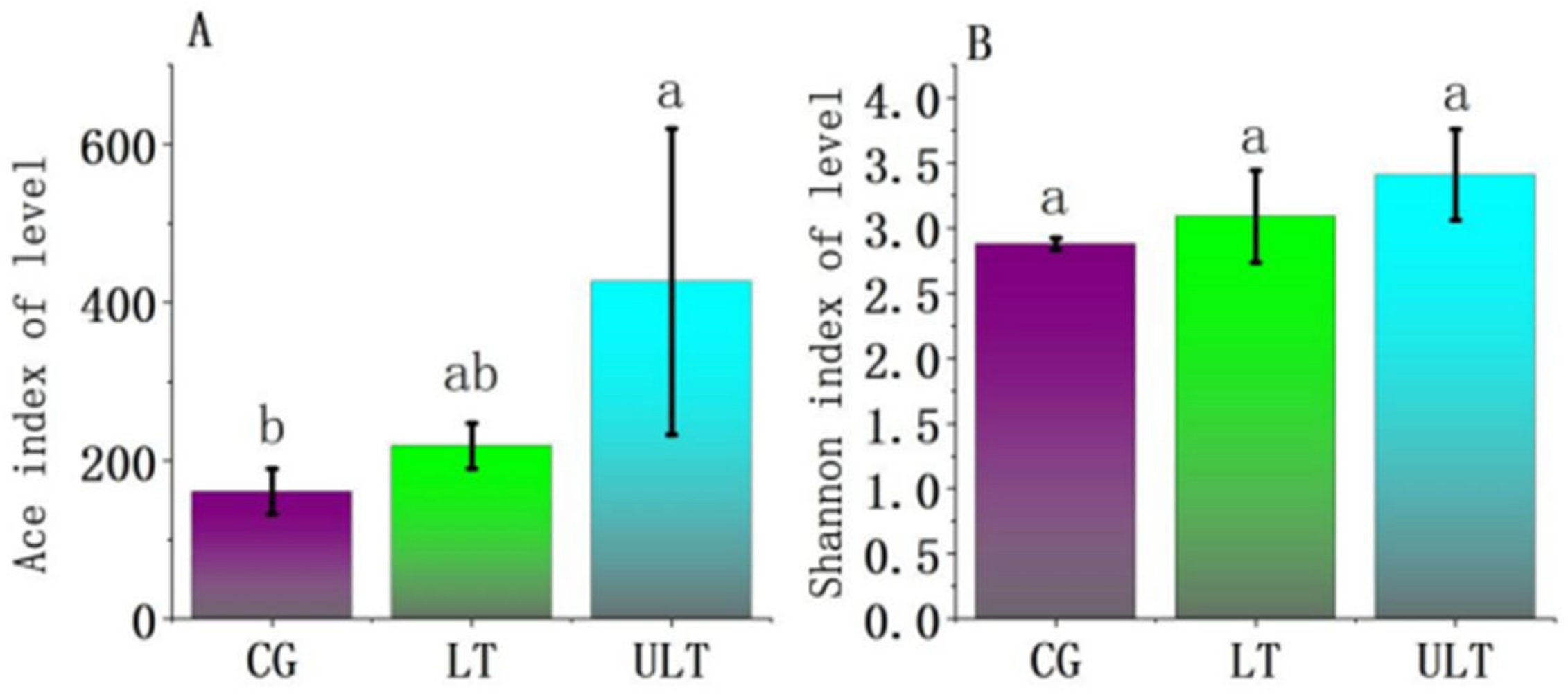
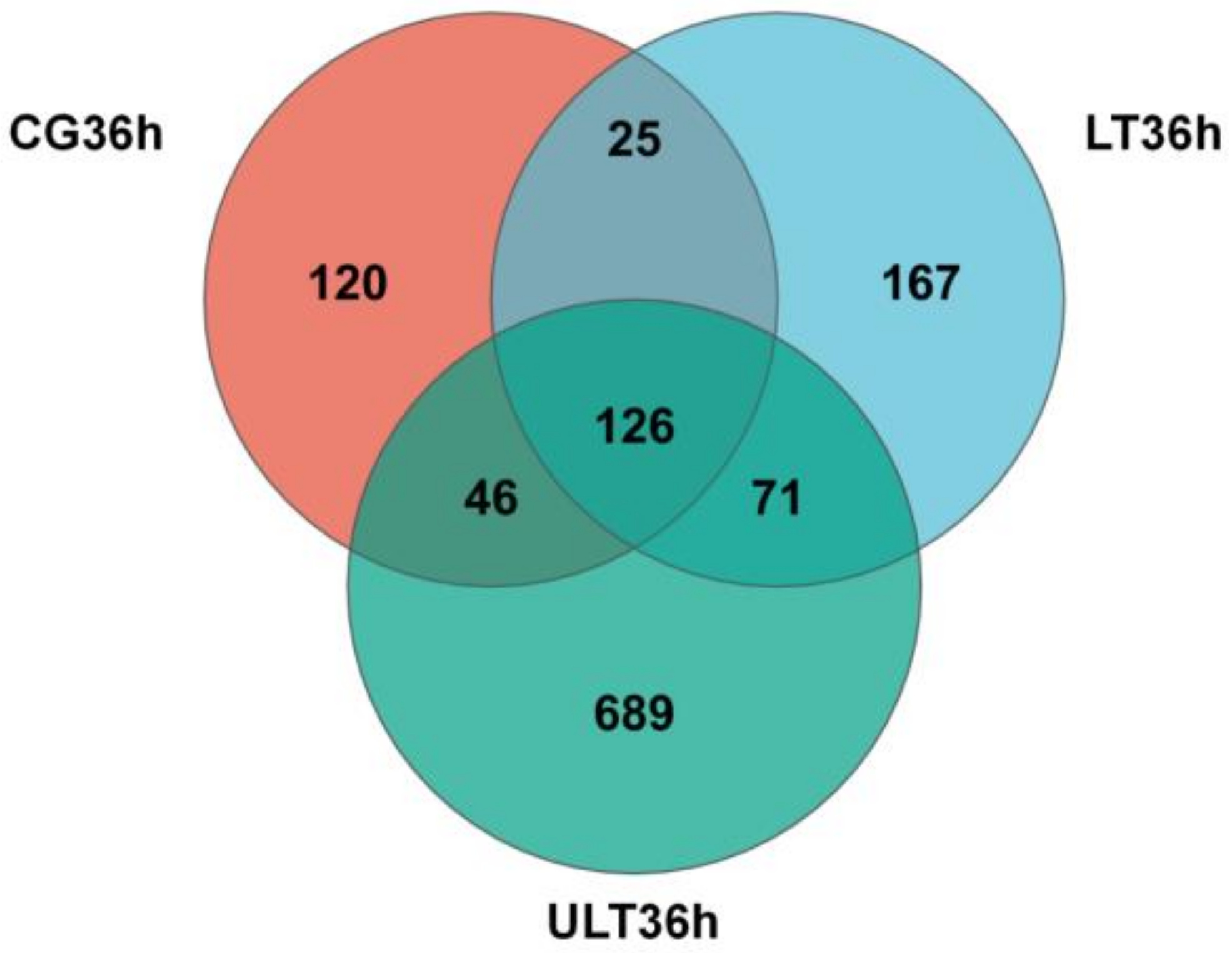
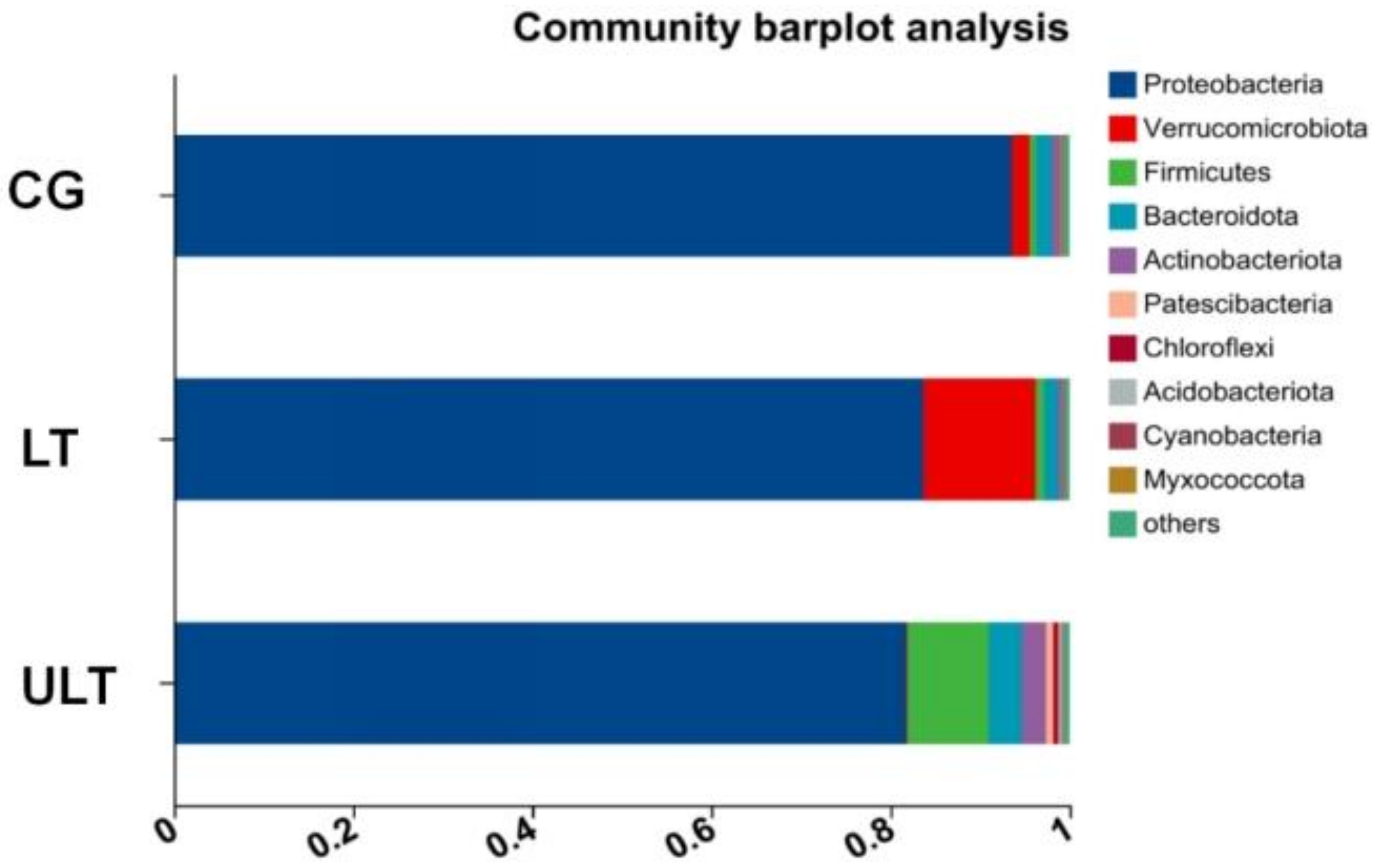

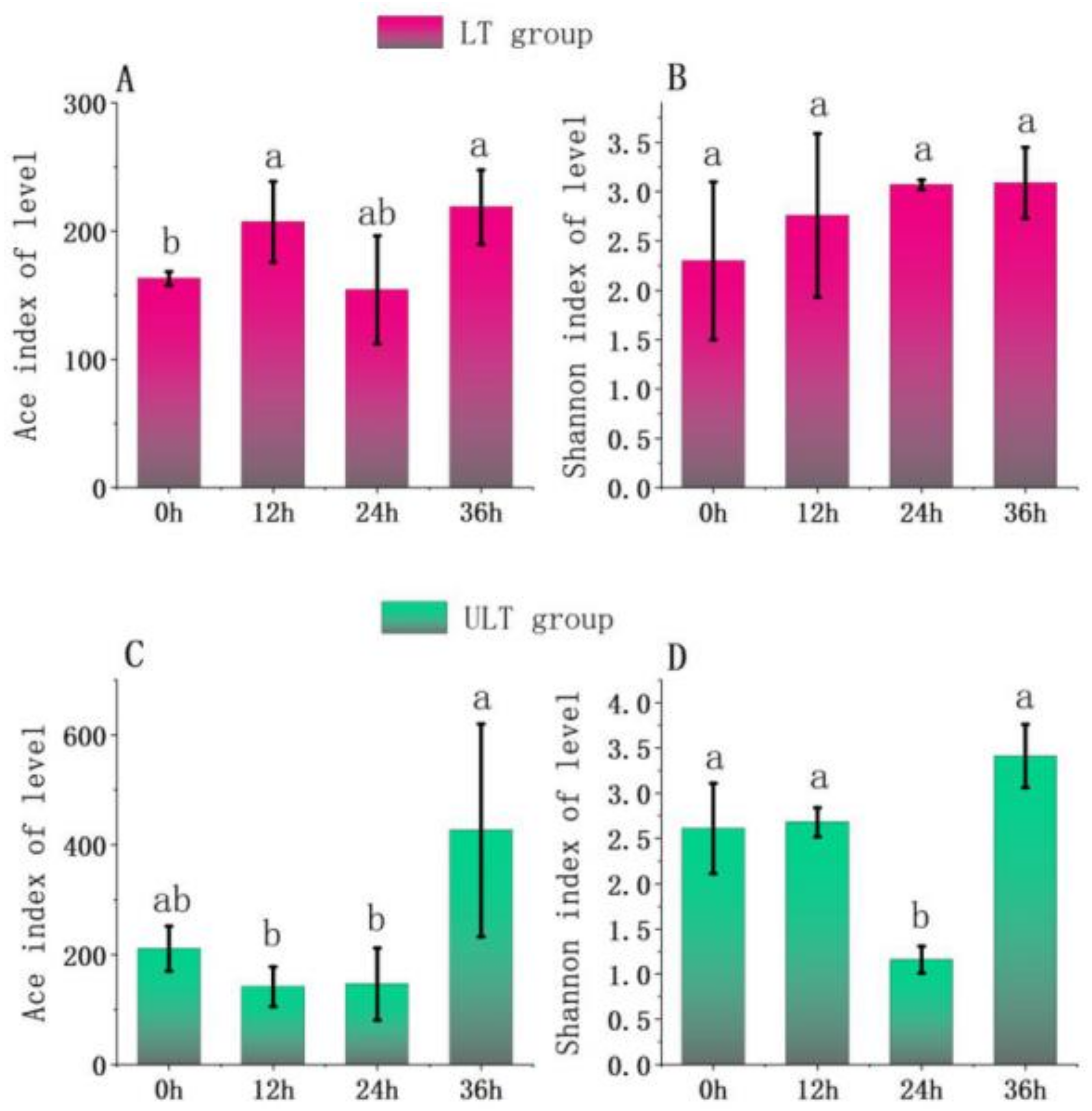


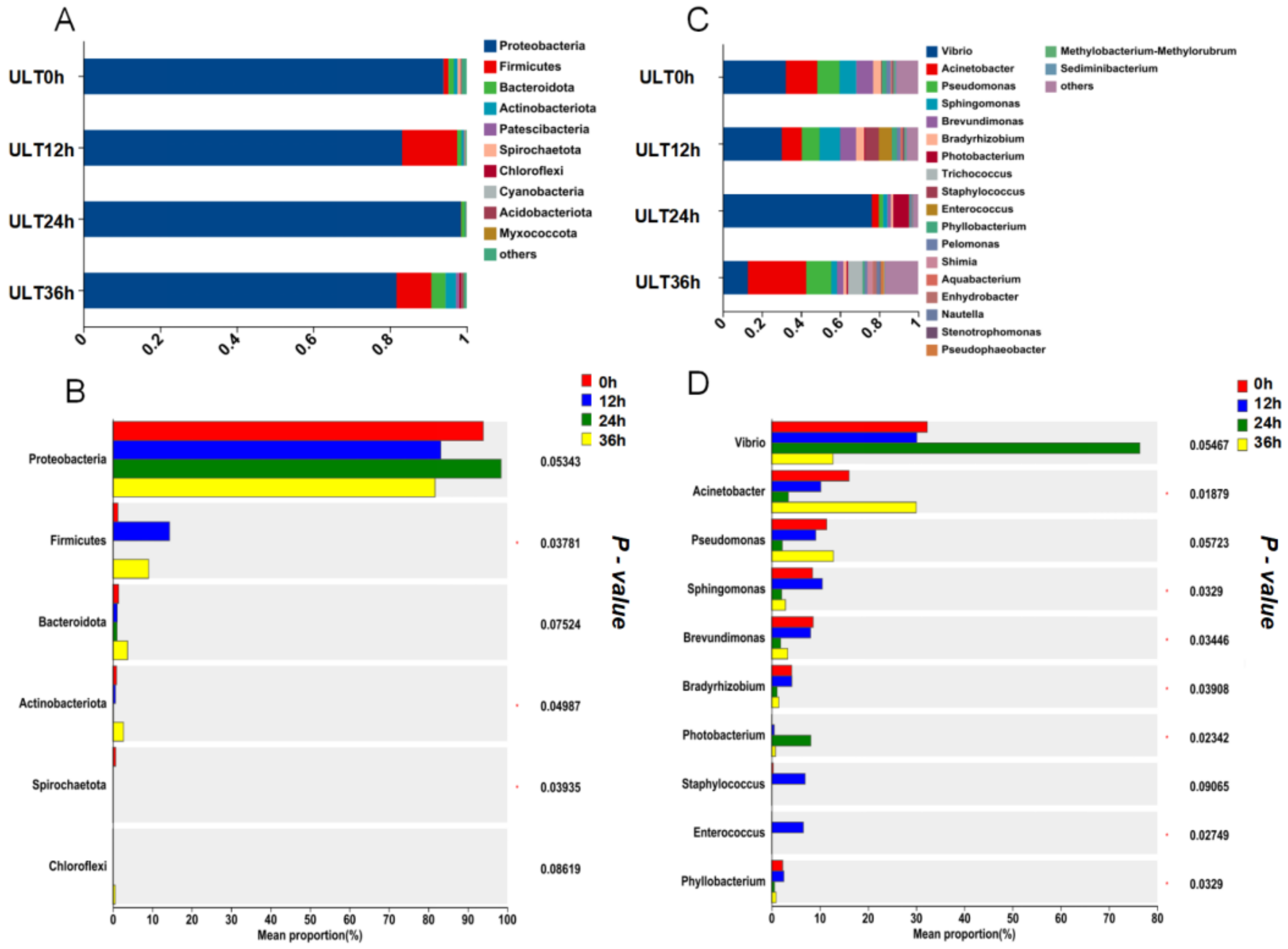
Disclaimer/Publisher’s Note: The statements, opinions and data contained in all publications are solely those of the individual author(s) and contributor(s) and not of MDPI and/or the editor(s). MDPI and/or the editor(s) disclaim responsibility for any injury to people or property resulting from any ideas, methods, instructions or products referred to in the content. |
© 2025 by the authors. Licensee MDPI, Basel, Switzerland. This article is an open access article distributed under the terms and conditions of the Creative Commons Attribution (CC BY) license (https://creativecommons.org/licenses/by/4.0/).
Share and Cite
Huang, J.; Fu, Z.; Yu, W.; Hou, B.; Wu, J.; Zhang, T.; Ma, Z. Gut Microbiota Response to Experimental Acute Cold Stress in Juvenile Yellowfin Tuna (Thunnus albacares). J. Mar. Sci. Eng. 2025, 13, 602. https://doi.org/10.3390/jmse13030602
Huang J, Fu Z, Yu W, Hou B, Wu J, Zhang T, Ma Z. Gut Microbiota Response to Experimental Acute Cold Stress in Juvenile Yellowfin Tuna (Thunnus albacares). Journal of Marine Science and Engineering. 2025; 13(3):602. https://doi.org/10.3390/jmse13030602
Chicago/Turabian StyleHuang, Junhua, Zhengyi Fu, Wei Yu, Bowen Hou, Jinhui Wu, Tao Zhang, and Zhenhua Ma. 2025. "Gut Microbiota Response to Experimental Acute Cold Stress in Juvenile Yellowfin Tuna (Thunnus albacares)" Journal of Marine Science and Engineering 13, no. 3: 602. https://doi.org/10.3390/jmse13030602
APA StyleHuang, J., Fu, Z., Yu, W., Hou, B., Wu, J., Zhang, T., & Ma, Z. (2025). Gut Microbiota Response to Experimental Acute Cold Stress in Juvenile Yellowfin Tuna (Thunnus albacares). Journal of Marine Science and Engineering, 13(3), 602. https://doi.org/10.3390/jmse13030602





